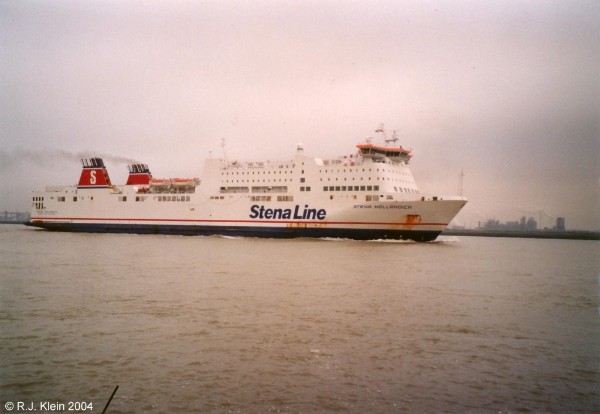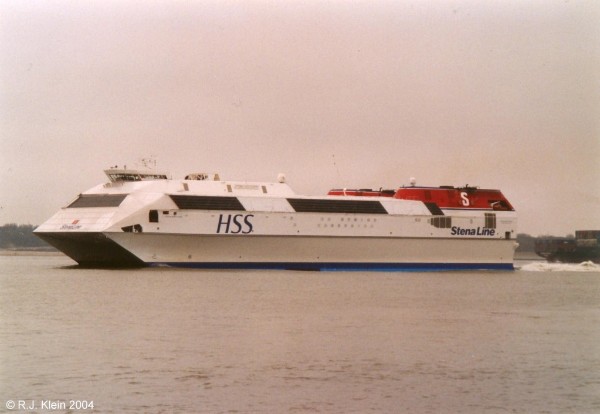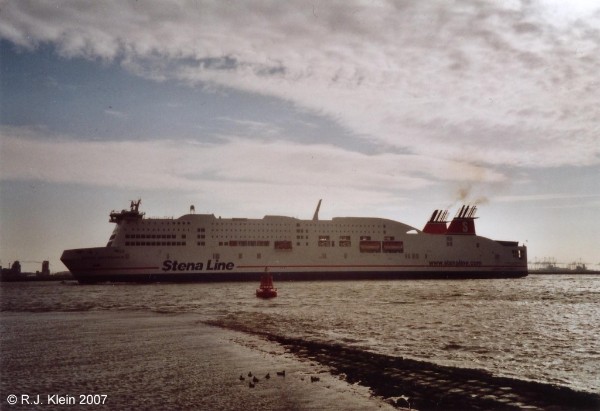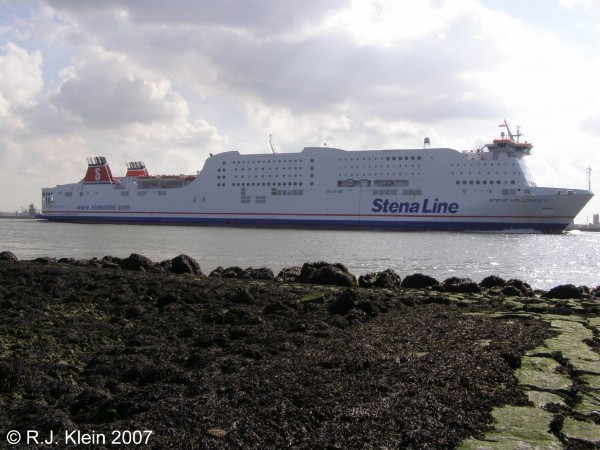Stena Line

The Stena Line was founded in 1939 by Sten Allan Olson (that's where the name comes from) in Sweden. At first, only freight was carried but in 1963 the first passengerferries were bought under the banner of Skagenlinjen A/B. The ships were sailing short routes at the western Baltic and the Kattengat. The current funnelcolours were also introduced then. In 1965 the name of Skagenlinjen was changed to Stena Line.
For a better service between Göteborg and Frederikshavn (Denmark), two new carferries were built in that same year, named Stena Danica and Stena Nordica. These were the first ships of the company with the Stena-name prefix. In the first years Stena experimented with different routes, also across the North Sea. Also, more ships were built and the company grew fast. In 1976, Stena Line entered the field of oil-rig supply vessels en they rebuilt a Norwegian car ferry for use as a floating hotel for contruction workers at the Shetland Islands. Also, they started to transport liquid gas and in the 1980's the Stena Caribbean Line was formed. The Stena Group became bigger in the years that followed. Now, Stena is involved in a number of fields, from carferries to hotels, sub-sea exploration, heavy lift, the shipments of crude oil, bulk-transport and containerisation. So they are much more than just a car-ferry company.

Hoek vanHolland to Harwich
Their involvement in Holland started in 1989, when at the 22nd of june the Stoomvaart Maatschappij Zeeland and their passengerships on the Hoek van Holland to Harwich route was taken over. The SMZ was one of the oldest shipping companies in the Netherlands, dating back 114 years to 1874. The other company that sailed at this route, the English Sealink, was also taken over in april 1990 and so the whole route came under Stena-management. At the 1st of january 1991 the English management was discontinued and the Dutch management became the only one for the company. The ships then sailing were the Koningin Beatrix (former SMZ) and the St. Nicholas (former Sealink). As a first move, Stena Line added a freightferry to the route, the 1973-built Stena Seatrader. Just six months later, the St. Nicholas was transferred to the Southampton to Cherbourg route and renamed Stena Normandy. Her replacement at the Hoek-Harwich route was the Stena Britannica (II), built in1981 as Silvia Regina.
Stena Britannica (II) was replaced in 1994 by the Stena Europe, a ship with almost the same capacity. But the major change for the route came in 1997 when Stena Line introduced Stena Discovery, a twin-hulled catamaran of enormous speed that could reduce sailing time from 8 hours to 3 and a half hours. This new engineering marvel replaced both carferries that were employed at other route's of Stena Line onwards. Also, a second freightferry was added to the route next to Stena Seatrader, the Stena Searider, built in 1969.

The problems with the highspeed ship started soon afterwards, when the Stena Discovery was creating huge waves at the quaysides and piers of Harwich and the smells of her exhausts were displeasing the people at Hoek van Holland. Also, in january 1998 a mammoth-wave smashed the nose of the ship and she had to be replaced by sistership Stena Voyager for restoring. In september of that same year, her jets were giving some problems so she had to be taken out of service again.
But the biggest problems were the lack of earnings and very high fuelcosts. Her introduction was massive, but the people did not flock to the new ship as hoped. The sailingscedule of two runs in each direction each day were not very satisfactory for the public with very early departures or late arrivals. To cope with this, two conventional ropax ferries were aded to the fleet in 2001. Their names were Stena Hollandica (I) and Stena Britannica (IV). These ships had a tonnage of around 33.000 and could accomodate 450 passengers each. These people were lorrydrivers and people with caravans. The general public was still using Stena Discovery only at this time. With their introduction, Stena Seatrader and Stena Searider were placed at the new Hoek van Holland to Killingholme freightroute.
But the fuel-hungry Stena Discovery was a thorn in the eye of the management of Stena Line. They were losing money and the introduction that had cost 300 million Dutch guilders for the ship and that same amount for changes at the quaysides to accomodate the ship could not be repaid. The growing freightvolumes compensated a bit, but not enough. The company even put itself up for sale at this moment. Something had to be done. At first, Stena Britannica (III) was replaced by a bigger ship of 44.000 tonnes with the same name in 2003. In 2006, the farewell of Stena Discovery was announced. She would not be replaced. Stena Britannica (IV) and Stena Hollandica would continue the route and would be enlarged for the use of daypassengers next to lorrydrivers. Their lenghening would be an enormous one. They would be enlarged to a lenght of 240 meters both, that meant the Stena Hollandica had to be lenghtened with a midsection of 52 meters, the longest lenghtening ever in passengership history. Also, the ships would become the longest ropax ferries in the world.


Stena Discovery was laid up in 2007 at Hoek van Holland, a sad ending for a ship that was to change the carferries on the North Sea forever. She was later moved to Belfast, next to the big Harland & Wolff yard. Stena said she would not be sold, because of the technology of the ship that has been claimed by Stena Line. Although this statement was made, the highspeed ferry was sold to Albamar, a company from Venezuela in may 2009. She was renamed a little to HSS Discovery with her new homeport Nassau. The ship sailed for South America in oktober, arriving there at the 26th of that month.

Just one year later, Stena Line announced that two new ropax ferries were going to be built to replace Stena Britannica (IV) and Stena Hollandica from 2010 onwards. These ships can be named the biggest ro-pax ferries in the world, with the dazzling lenght of 240 meters. With that introduction, the Stena Line route between Hoek van Holland and Harwich will be one of the most modern in Europe. These ships and their story can be visited here.

